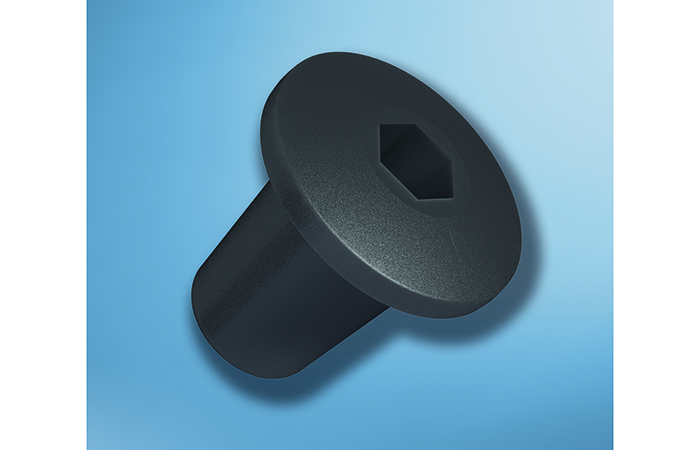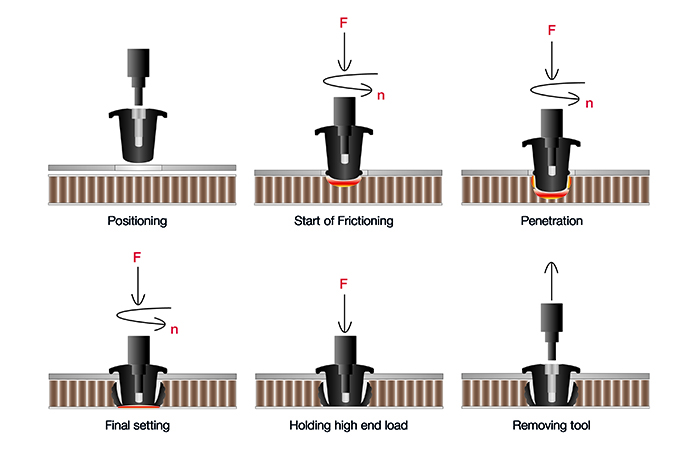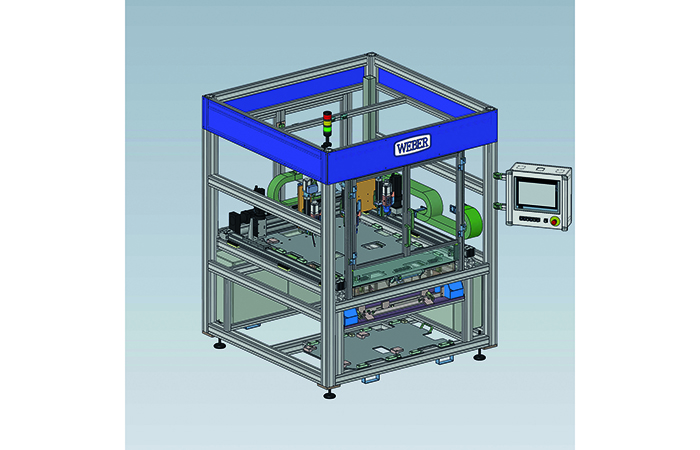
Intelligent lightweight design is the driver of much R&D in many sectors - for example in the automotive industry, which must prioritise energy savings which in turn help to meet stringent emissions limits. New processes increasingly utilise lightweight yet strong and durable materials, such as CFRP and GFRP laminates with honeycomb and foam cores.
Fastening technology must also keep pace with these developments. EJOT, world leader in the design and development of high-performance fasteners for all materials and all industrial processes, is already ahead of the field with its TSSD® system for lightweight materials.

The EJOT TSSD® system is a rapid and outstandingly strong thermal adhesive fastening system. It is designed to offer significant assembly time and performance advantages when used with a wide range of lightweight materials across all industry sectors.
EJOT’s thermal adhesive bonding boss - its name TSSD® is derived from the German Thermischer Stoff-Schluss-Dom - combines both an innovative fastening product and its factory assembly process.
Underpinned by a century of EJOT expertise, the TSSD® system is a game-changing new fastener technology for lightweight composite materials that delivers two principal benefits.
First, the bonding boss itself (see illustrations) is lightweight yet outstandingly strong and versatile, making it suitable for a great many applications that require reliable fastening to lightweight materials. Second, the rapid fixing process requires no pre-drilling or other surface preparation and can be automated for repeatability to any customer specification.
Since most lightweight materials are of hybrid design and construction, it is critical to have a fastener technology available that product developers can trust from the outset. This is particularly important when dissimilar materials must be joined together. EJOT’s global reputation for quality and customer support is a good foundation for designer confidence.
Until the advent of EJOT’s TSSD® system, much fastening practice has depended on a combination of bonding and auxiliary joining elements. These processes are time-consuming and costly as they require component preparation (pre-hole drilling, sanding, cleaning and/or application of additional activators). The long curing time of some adhesives can cause further unwanted delays before the next process or before the fastening elements can be loaded.
Evolution of the TSSD® system
EJOT’s fastening technology team tasked specifically with developing the TSSD® system looked at the many possible permutations of core material and surface layers used in sandwich structures.
The core might be foamed material such as EPP, PET or PUR, or at higher rigidities honeycomb structures comprising thermoplastics (usually PP), aramid fibre composites or paper. Combinations of materials are also technically feasible. The primary focus of the core material is usually its mechanical properties, but for outward facing layers visual appearance is often a key additional criterion. GFRP and CFRP materials, aluminium, thin sheets or veneers, including wood, may be used depending on the application.
Owing to the weight reduction imperative, a requirement for sandwich or composite materials is growing rapidly in most industry sectors. An R&D and design objective is to maintain the mechanical properties of conventional materials while reducing the weight associated with them.
Ranging comprehensively from vehicle interiors - for example door panels, boot floors or complex seat structures - to aircraft or marine components, construction materials, sports and leisure products, even toys, the range of potential TSSD® applications is already enormous and can only continue to grow.
Following extensive development and testing, the EJOT TSSD® system will fully meet any requirement for high-capacity and durable fastening of lightweight materials without time-consuming component preparation.
The TSSD® system can be made available in sizes to suit specific applications. Product developers will also benefit from the ready availability of EJOT knowhow and data that will make it easier to predict performance and reduce the need for testing.
How the TSSD® boss works (see illustrations)
- Upon touching the surface of the material to be fastened, the TSSD® boss is accelerated to a predetermined speed and loading. The resulting friction rapidly heats the upper layer of the composite material to a temperature that enables the boss to penetrate it.
- After penetration, the partly fused TSSD® boss ‘flows’ into the hollow chambers of the core, forming a positive-locked joint.
- Once the boss reaches its final position, any expelled content of the top layer becomes embedded in the partly fused rim area of the thermoplastic boss, adhering to it when it has solidified completely. This generates additional strength, adhesion and form fit bonding.
Usually no pre-hole in the outer layer is required. The bosses may be used as screw bosses or as direct fastening elements.
Depending on design and the customer specification, provision can be made for detachable or non-detachable connections.
The TSSD® system - a compelling proposition
EJOT has developed an online data pool for the TSSD® joining process, where designers can find standard values based on extensive trials. These values support optimal pre-dimensioning of the joint and reduce the need for component tests.
TSSD® bosses can be installed either fully- or semi-automatically with a setting spindle from fastening technology machinery specialist Weber in partnership with EJOT. To create an optimised joint, different rotation speeds can be programmed (up to 5,000 rpm in three stages). Depending on application and component size, either a portal or robotic system can be used.

The TSSD® is already used in the German automotive industry, where it has been hailed as the future standard. The potential advantage for companies working with or developing lightweight structures is clear, particularly in the field of GFRP and CFRP materials.
A final but major consideration is that the EJOT TSSD® system is itself the result of extensive R&D by the unrivalled world experts in fastener technology. Lightweight material or product development time and costs can be saved simply by partnering with EJOT for access to in-depth fastening expertise fit not just for today but for tomorrow.
https://www.ejot.co.uk/indsutrial-lightweight-fastening-tssd-eppsys










Water Sector Talent Exodus Could Cripple The Sector
My local water company is Severn Trent which has a market capitalisation of £8.2 billion, made a pre-tax profit of £200 million in 2024 and is paying...